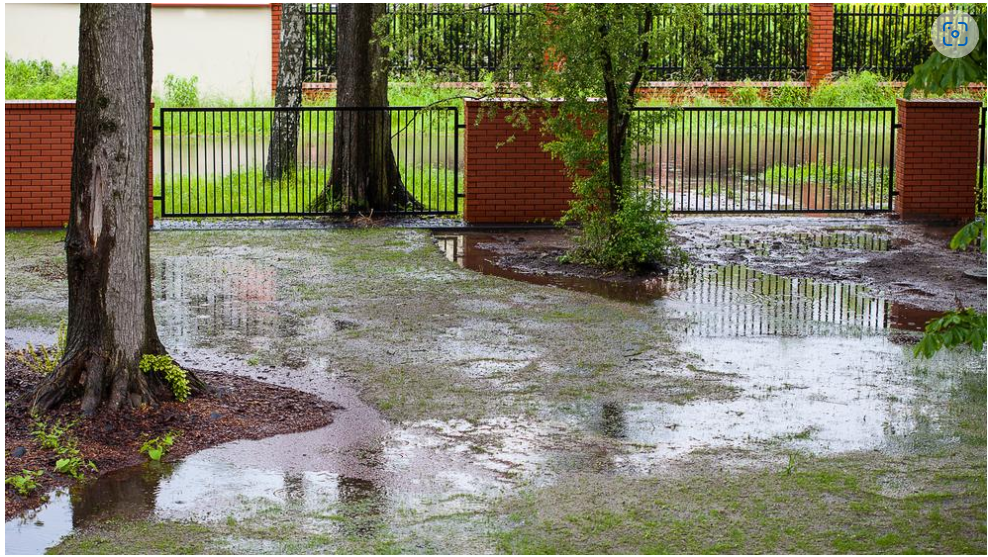
A dripping spigot, a soil depression against your house or a yard graded toward your foundation can lead to soggy soil. Having soggy soil next to or near your home can cause serious damage that isn’t insured.
Depending on the foundation of your home, you have several major issues to consider when it comes to moisture. We’ll look at four that are not covered by insurance but can cause major damage.
1. Cracks in the foundation or slab
When people hear of a cracked foundation, their minds often go to earthquakes or other traumatic events. But ground moisture is a prevalent cause of foundation damage, too. Improperly drained or graded yards can cause expansion of the soil that supports the foundation of your home. When that soil shrinks back during periods of dryness, it can cause unevenness in your support system. This often results in cracks in the foundation, slab or interior wall joints.
Chronic moisture can also create rot in wood that touches the ground, including posts sitting on concrete footers. Even if those posts are treated for outdoor use, over time continuous exposure to soggy soil will compromise them.
Structural damage due to earthquakes or floods can be insured, but damage caused by a failure to address ongoing moisture is not covered.
2. Subsidence and erosion
Subsidence is the gradual sinking of an area of land. It can be as dramatic as a sinkhole or as subtle as a slight depression in the ground. It happens when soil rinses away, compacts due to moisture deprivation, or softens dramatically because of being chronically wet. It may also occur due to the placement of heavy objects, such as an air conditioner or a storage unit, on wet ground over long periods of time.
Subsidence under a house, as described above, can cause unsupported pockets under a foundation, slab or pier. Subsidence next to a house creates places where water can pool and begin to soak under the home or into the walls.
Erosion can also be caused by sogginess as mud gradually slides away and reduces support for foundational systems. Some houses will slide apart as erosion removes support from one side of a building.
3. Interior mold
Porous materials such as concrete, brick and wood absorb water. When the exposure is temporary, such as during a rainstorm, they dry out, and the interior of your home is protected. But when they are not allowed to dry because the moisture is constant, water will eventually wick inside. This affects the structure’s frame and potentially even wall boards, floors and furniture sitting against walls.
The first thing owners with this problem may notice is a musty or strange smell, especially in closets and basements. It could take many months or even years for mold to appear in the interior of the home, but when it does, major renovations may be needed.
4. Pests
Roaches, ants, termites and worms love moisture. If water is allowed to pool against exterior walls or invade crawl spaces, you could be setting yourself up for a veritable zoo of insects. The damage they do can be severe and nasty — and it’s not covered by insurance.
Solutions to protect your home
Routing water away from the base of a structure is crucial for avoiding subsidence, erosion, foundation damage, moisture intrusion and pests. But simply draining it a few feet away, as many downspout systems do, might not be enough to protect your home.
Many people use drainage tubes that attach to downspouts to route rainwater far away from structures toward gardens, woodland, public sewers or retention ponds. Distributing rainwater into areas designed to allow it to pool and seep slowly into the ground is also a good way to refill aquifers and reduce surface water and runoff.
You need to be thoughtful about your landscaping, too. Trees that take lots of water should not be planted near the home. Instead, plant them near swales, flood plains or retention ponds.
Fix leaky spigots, regrade if erosion or subsidence has created depressions near walls, and rake up leaves and other debris that prevent proper evaporation of soil water. Maintaining clear gutters will also allow your built-in protection systems to keep moisture under control.
With the right attention to your home’s exterior, you will avoid all sorts of damage that’s excluded from your homeowners insurance policy.
Copyright © 2023 Applied Systems, Inc. All rights reserved.
